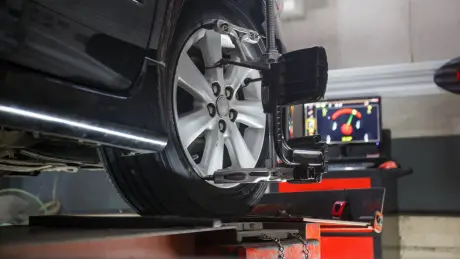
Have you ever felt that your car is drifting to either side of the road, and you have to fight with the steering to keep it stable? If yes, it might be an alignment issue. Some people call it wheel alignment, while others also call it tire or car alignment. The wheel alignment can not only make your ride smoother and safer, but it can also increase the fuel mileage and life expectancy of tires.
Do you think that a car has 4 wheels, so all of them need an alignment? Well, that might not be the case. There are 3 types of wheel alignments: front end, thrust angle, and four-wheel.
Let's break each of them down for better understanding.
Front End Wheel Alignment
A two-wheel alignment or front-end alignment means that only the front two tires are measured and aligned. This type of alignment is carried out on cars that have a fixed rear axle. Another critical thing to watch is that the front two tires should be symmetrical with the rear tires.
Thrust Angle Wheel Alignment
In cars with a fixed rear axle, to align all four tires, mechanics perform a thrust angle alignment. This alignment can also identify vehicles that would dog track on the road (it means that rear tires are not in symmetry with the front tires). You might have to make some frame adjustments to bring the rear axle in place.
Four-Wheel Alignment
As the name suggests, in four-wheel alignment, all four wheels of a vehicle are aligned. All those cars possess an independent 4-tire suspension system with the front tires and rear tires all are aligned separately to make them square and stable.
What Causes Out of Alignment Wheels
One of the significant causes is aging. With time tire suspension systems wears down, and tires do not work at their proper angles. Usually, you might not even notice that your wheels are out of alignment. But some of the systems to identify this problem are:
- It feels like your car is being pulled.
- The steering wheel is off-center while traveling in a straight line.
- Uneven wearing of tires can also be a sign.
The Primary Angles of an Alignment:
Among the three types of alignments, no matter which you might need, the major angles which need to be adjusted are camber, caster, thrust, and toe.
Camber
The angle of front tires that can be observed from the car's front side is known as camber. View the tires from the front if they are leaning on either side rather than being completely vertical; it means there is a misalignment. This sort of misalignment can cause the edges of tires to wear down quickly.
Caster
Caster angle impacts the stability, cornering, and steering ability of the car. When the top of the steering axis tilts towards rear tires it is known as a positive caster, and when the steering axis leans towards the front tires it is called a negative caster. This condition decreases your control of the car.
Toe
The toe angle shows the direction the tires are pointing, keeping the vehicle's centerline as the reference point. Toe-in means the tires are pointing towards the centerline, and Tow-out means the tires are pointing away from the centerline.
Thrust Angle
In thrust angle, the alignment of the rear axle is measured by keeping the centerline as the reference. Keep in mind that the thrust line makes an angle of 90 degrees with the posterior axis.
Same articles

Understanding Vehicle Inspection and Verification Services: Why They Matter for Every Driver
GuidesVehicle inspection and verification services are an essential but often overlooked part of keeping roads safe and cars legally compliant. Most people only think about inspections when it’s...
KLIFEX Brand Overview: High-Quality Automotive Repair Kits for Affordable Repairs
GuidesThe automotive aftermarket has long needed solutions that combine reliability, durability, and affordability. Many car enthusiasts and services are looking for a way...
Fast, Reliable Vehicle Emissions & Inspection Services Made Simple
GuidesFast, reliable emissions and inspection services are essential for keeping vehicles road-ready, compliant with environmental regulations, and safe for daily driving. If you’re looking for quick...

